A 0.3 V OTA with Enhanced CMRR and High Robustness to PVT Variations
Abstract
1. Introduction
2. Proposed Amplifier
2.1. Topology Description
2.2. Analysis of Biasing Approach
2.3. Differential-Mode Analysis
2.4. Common-Mode Analysis
2.5. Noise Analysis
2.6. Distortions
3. Circuit Design and Simulation
4. Conclusions
Author Contributions
Funding
Data Availability Statement
Conflicts of Interest
Abbreviations
| ADC | Analog-to-Digital Converter |
| BD | Body-driven |
| CAD | Computer-Aided Design |
| CMFB | Common-Mode Feedback |
| CMFF | Common-Mode Feedforward |
| CMOS | Complementary Metal-Oxide-Semiconductor |
| CMRR | Common-Mode Rejection Ratio |
| D2S | Differential-to-Single-Ended |
| DIBL | Drain-Induced Barrier Lowering |
| DIGOTA | Digital Operational Transconductance Amplifier |
| GBW | Gain-bandwidth product |
| GD | Gate-driven |
| IB | Inverter-based |
| IoT | Internet-of-Things |
| LDO | Low-Dropout Regulator |
| OTA | Operational Transconductance Amplifier |
| PSRR | Power Supply Rejection Ratio |
| PVT | Process, supply voltage and temperature |
| SR | Slew Rate |
| THD | Total Harmonic Distortion |
| ULP | Ultra-Low Power |
| ULV | Ultra-Low Voltage |
| UOPA | Unbuffered Operational Amplifier |
References
- Chandrakasan, A.P.; Verma, N.; Daly, D.C. Ultralow-power electronics for biomedical applications. Annu. Rev. Biomed. Eng. 2008, 10, 247–274. [Google Scholar] [CrossRef] [PubMed]
- Ng, K.A.; Xu, Y.P. A low-power, high CMRR neural amplifier system employing CMOS inverter-based OTAs with CMFB through supply rails. IEEE J. Solid-State Circuits 2016, 51, 724–737. [Google Scholar] [CrossRef]
- Centurelli, F.; Fava, A.; Monsurró, P.; Scotti, G.; Tommasino, P.; Trifiletti, A. Low power switched-resistor band-pass filter for neural recording channels in 130 nm CMOS. Heliyon 2020, 6, e04723. [Google Scholar] [CrossRef] [PubMed]
- Sobin, C.C. A survey on architecture, protocols and challenges in IoT. Wirel. Pers. Commun. 2020, 112, 1383–1429. [Google Scholar] [CrossRef]
- Wardlaw, J.L.; Karaman, I.; Karsilayan, A.İ. Low-power circuits and energy harvesting for structural health monitoring of bridges. IEEE Sens. J. 2013, 13, 709–722. [Google Scholar] [CrossRef]
- Chi, Q.; Yan, H.; Zhang, C.; Pang, Z.; Li, D.X. A reconfigurable smart sensor interface for industrial WSN in IoT environment. IEEE Trans. Ind. Inf. 2014, 10, 1417–1425. [Google Scholar] [CrossRef]
- Harpe, P.; Gao, H.; van Dommele, R.; Cantatore, E.; Van Roermund, A.H.M. A 0.20 mm2 3 nW signal acquisition IC for miniature sensor nodes in 65 nm CMOS. IEEE J. Solid-State Circuits 2016, 51, 240–248. [Google Scholar] [CrossRef]
- Abella, C.S.; Bonina, S.; Cucuccio, A.; D’Angelo, S.; Giustolisi, G.; Grasso, A.D.; Imbruglia, A.; Mauro, G.S.; Nastasi, G.A.M.; Palumbo, G.; et al. Autonomous energy-efficient wireless sensor network platform for home/office automation. IEEE Sens. J. 2019, 19, 3501–3512. [Google Scholar] [CrossRef]
- Carrara, S. Body dust: Well beyond wearable and implantable sensors. IEEE Sens. J. 2021, 21, 12398–12406. [Google Scholar] [CrossRef]
- Aledhari, M.; Razzak, R.; Qolomany, B.; Al-Fuqaha, A.; Saeed, F. Biomedical IoT: Enabling technologies, architectural elements, challenges, and future directions. IEEE Access 2022, 10, 31306–31339. [Google Scholar] [CrossRef]
- Bock, D.C.; Marschilok, A.C.; Takeuchi, K.J.; Takeuchi, E.S. Batteries used to power implantable biomedical devices. Electrochim. Acta 2012, 84, 155–164. [Google Scholar] [CrossRef] [PubMed]
- Elahi, H.; Munir, K.; Eugeni, M.; Atek, S.; Gaudenzi, P. Energy harvesting towards self-powered IoT devices. Energies 2020, 13, 5528. [Google Scholar] [CrossRef]
- Grossi, M. Energy harvesting strategies for wireless sensor networks and mobile devices: A review. Electronics 2021, 10, 661. [Google Scholar] [CrossRef]
- Sanislav, T.; Mois, G.D.; Zeadally, S.; Folea, S.C. Energy harvesting techniques for Internet of Things (IoT). IEEE Access 2021, 9, 39530–39549. [Google Scholar] [CrossRef]
- Lin, C.Y.; Chen, W.L.; Ker, M.D. Implantable stimulator for epileptic seizure suppression with loading impedance adaptability. IEEE Trans. Biomed. Circuits Syst. 2013, 7, 196–203. [Google Scholar] [CrossRef] [PubMed]
- Hannan, M.A.; Mutashar, S.; Samad, S.A.; Hussain, A. Energy harvesting for the implantable biomedical devices: Issues and challenges. Biomed. Eng. Online 2014, 13, 79. [Google Scholar] [CrossRef] [PubMed]
- Wu, T.; Redouté, J.M.; Yuce, M.R. A wireless implantable sensor design with subcutaneous energy harvesting for long-term IoT healthcare applications. IEEE Access 2018, 6, 35801–35808. [Google Scholar] [CrossRef]
- Khateb, F.; Dabbous, S.B.A.; Vlassis, S. A survey of non-conventional techniques for low-voltage low-power analog circuit design. Radioengineering 2013, 22, 415–427. [Google Scholar]
- Toledo, P.; Rubino, R.; Musolino, F.; Crovetti, P. Re-thinking analog integrated circuits in digital terms: A new design concept for the IoT era. IEEE Trans. Circuits Syst. II 2021, 68, 816–822. [Google Scholar] [CrossRef]
- Richelli, A.; Colalongo, L.; Kovacs-Vajna, Z.; Calvetti, G.; Ferrari, D.; Finanzini, M.; Pinetti, S.; Prevosti, E.; Savoldelli, J.; Scarlassara, S. A survey of low voltage and low power amplifier topologies. J. Low Power Electron. Appl. 2018, 8, 22. [Google Scholar] [CrossRef]
- Grasso, A.D.; Pennisi, S. Ultra-low power amplifiers for IoT nodes. In Proceedings of the 2018 25th IEEE International Conference on Electronics, Circuits and Systems (ICECS), Bordeaux, France, 9–12 December 2018; pp. 497–500. [Google Scholar] [CrossRef]
- Toledo, P.; Crovetti, P.; Aiello, O.; Alioto, M. Design of digital OTAs with operation down to 0.3 V and nW power for direct harvesting. IEEE Trans. Circuits Syst. I 2021, 68, 3693–3706. [Google Scholar] [CrossRef]
- Richelli, A.; Faustini, P.; Rosa, A.; Colalongo, L. An investigation of the operating principles and power consumption of digital-based analog amplifiers. J. Low Power Electron. Appl. 2023, 13, 51. [Google Scholar] [CrossRef]
- Privitera, M.; Crovetti, P.; Grasso, A.D. A novel digital OTA topology with 66-dB DC gain and 12.3-kHz bandwidth. IEEE Trans. Circuits Syst. II 2023, 70, 3988–3992. [Google Scholar] [CrossRef]
- Drost, B.; Talegaonkar, M.; Hanumolu, P.K. Analog filter design using ring oscillator integrators. IEEE J. Solid-State Circuits 2012, 47, 3120–3129. [Google Scholar] [CrossRef]
- Kalani, S.; Haque, T.; Gupta, R.; Kinget, P.R. Benefits of using VCO-OTAs to construct TIAs in wideband current-mode receivers over inverter-based OTAs. IEEE Trans. Circuits Syst. I 2019, 66, 1681–1691. [Google Scholar] [CrossRef]
- Chatterjee, S.; Tsividis, Y.; Kinget, P. 0.5-V analog circuit techniques and their application in OTA and filter design. IEEE J. Solid-State Circuits 2005, 40, 2373–2387. [Google Scholar] [CrossRef]
- Ferreira, L.H.C.; Sonkusale, S.R. A 60-dB gain OTA operating at 0.25-V power supply in 130-nm digital CMOS process. IEEE Trans. Circuits Syst. I 2014, 61, 1609–1617. [Google Scholar] [CrossRef]
- Abdelfattah, O.; Roberts, G.W.; Shih, I.; Shih, Y.C. An ultra-low-voltage CMOS process-insensitive self-biased OTA with rail-to-rail input range. IEEE Trans. Circuits Syst. I 2015, 62, 2380–2390. [Google Scholar] [CrossRef]
- Akbari, M.; Hashemipour, O. A 63-dB gain OTA operating in subthreshold with 20-nW power consumption. Int. J. Circuit Theory Appl. 2017, 45, 843–850. [Google Scholar] [CrossRef]
- Kulej, T.; Khateb, F. Design and implementation of sub 0.5-V OTAs in 0.18-μm CMOS. Int. J. Circuit Theory Appl. 2018, 46, 1129–1143. [Google Scholar] [CrossRef]
- Wen, B.; Zhang, Q.; Zhao, X. A two-stage CMOS OTA with enhanced transconductance and DC-gain. Analog Integr. Circuits Sig. Process. 2019, 98, 257–264. [Google Scholar] [CrossRef]
- Kulej, T.; Khateb, F. A compact 0.3-V class AB bulk-driven OTA. IEEE Trans. Very Large Scale Integr. VLSI Syst. 2020, 28, 224–232. [Google Scholar] [CrossRef]
- Kulej, T.; Khateb, F. A 0.3-V 98-dB rail-to-rail OTA in 0.18 μm CMOS. IEEE Access 2020, 8, 27459–27467. [Google Scholar] [CrossRef]
- Woo, K.C.; Yang, B.D. A 0.25-V rail-to-rail three-stage OTA with an enhanced DC gain. IEEE Trans. Circuits Syst. II 2020, 67, 1179–1183. [Google Scholar] [CrossRef]
- Deo, N.; Sharan, T.; Dubey, T. Subthreshold biased enhanced bulk-driven double recycling current mirror OTA. Analog Integr. Circuits Sig. Process. 2020, 105, 229–242. [Google Scholar] [CrossRef]
- Wang, Y.; Zhang, Q.; Zhao, X.; Dong, L. An enhanced bulk-driven OTA with high transconductance against CMOS scaling. AEU Int. J. Electron. Commun. 2021, 130, 153581. [Google Scholar] [CrossRef]
- Centurelli, F.; Della Sala, R.; Scotti, G.; Trifiletti, A. A 0.3 V, rail-to-rail, ultralow-power, non-tailed, body-driven, sub-threshold amplifier. Appl. Sci. 2021, 11, 2528. [Google Scholar] [CrossRef]
- Centurelli, F.; Della Sala, R.; Monsurró, P.; Scotti, G.; Trifiletti, A. A tree-based architecture for high-performance ultra-low-voltage amplifiers. J. Low Power Electron. Appl. 2022, 12, 12. [Google Scholar] [CrossRef]
- Centurelli, F.; Della Sala, R.; Monsurró, P.; Tommasino, P.; Trifiletti, A. An ultra-low-voltage class-AB OTA exploiting local CMFB and body-to-gate interface. AEU Int. J. Electron. Commun. 2022, 145, 154081. [Google Scholar] [CrossRef]
- Dong, S.; Wang, W.; Tong, X. A 0.25-V 90 dB PVT-stabilized four-stage OTA withmidrulear Q-factor modulation and fast slew-rate enhancement for ultra-low supply ADCs. AEU Int. J. Electron. Commun. 2022, 144, 154044. [Google Scholar] [CrossRef]
- Ballo, A.; Grasso, A.D.; Pennisi, S. 0.4-V, 81.3-nA bulk-driven single-stage CMOS OTA with enhanced transconductance. Electronics 2022, 11, 2704. [Google Scholar] [CrossRef]
- Della Sala, R.; Centurelli, F.; Scotti, G.; Tommasino, P.; Trifiletti, A. A differential-to-single-ended converter based on enhanced body-driven current mirrors targeting ultra-low-voltage OTAs. Electronics 2022, 11, 3838. [Google Scholar] [CrossRef]
- Della Sala, R.; Centurelli, F.; Monsurrò, P.; Scotti, G.; Trifiletti, A. A 0.3V rail-to-rail three-stage OTA with high DC gain and improved robustness to PVT variations. IEEE Access 2023, 11, 19635–19644. [Google Scholar] [CrossRef]
- Ballo, A.; Grasso, A.D.D.; Pennisi, S.; Susinni, G. A 0.3-V 8.5-μ a bulk-driven OTA. IEEE Trans. Very Large Scale Integr. VLSI Syst. 2023, 31, 1444–1448. [Google Scholar] [CrossRef]
- Miguel, J.M.A.; Lopez-Martin, A.J.; Acosta, L.; Ramirez-Angulo, J.; Carvajal, R.G. Using floating gate and quasi-floating gate techniques for rail-to-rail tunable CMOS transconductor design. IEEE Trans. Circuits Syst. I 2011, 58, 1604–1614. [Google Scholar] [CrossRef]
- Khateb, F. Bulk-driven floating-gate and bulk-driven quasi-floating-gate techniques for low-voltage low-power analog circuits design. AEU Int. J. Electron. Commun. 2014, 68, 64–72. [Google Scholar] [CrossRef]
- Braga, R.A.S.; Ferreira, L.H.C.; Coletta, G.D.; Dutra, O.O. A 0.25-V calibration-less inverter-based OTA for low-frequency Gm-C applications. Microelectron. J. 2019, 83, 62–72. [Google Scholar] [CrossRef]
- Lv, L.; Zhou, X.; Qiao, Z.; Li, Q. Inverter-based subthreshold amplifier techniques and their application in 0.3-V ΔΣ-modulators. IEEE J. Solid-State Circuits 2019, 54, 1436–1445. [Google Scholar] [CrossRef]
- Manfredini, G.; Catania, A.; Benvenuti, L.; Cicalini, M.; Piotto, M.; Bruschi, P. Ultra-low-voltage inverter-based amplifier with novel common-mode stabilization loop. Electronics 2020, 9, 1019. [Google Scholar] [CrossRef]
- Rodovalho, L.H.; Aiello, O.; Rodrigues, C.R. Ultra-low-voltage inverter-based operational transconductance amplifiers with voltage gain enhancement by improved composite transistors. Electronics 2020, 9, 1410. [Google Scholar] [CrossRef]
- Liu, Y.; Zhang, B.; Cheng, X.; Han, J.; Zeng, X. A 0.9V all digital synthesizable OPAMP with boosted gain and widened common mode input range. In Proceedings of the 2020 IEEE 15th International Conference on Solid-State & Integrated Circuit Technology (ICSICT), Kunming, China, 3–6 November 2020; pp. 1–3. [Google Scholar] [CrossRef]
- Della Sala, R.; Centurelli, F.; Scotti, G. A novel differential to single-ended converter for ultra-low-voltage inverter-based OTAs. IEEE Access 2022, 10, 98179–98190. [Google Scholar] [CrossRef]
- Della Sala, R.; Centurelli, F.; Scotti, G. Enabling ULV fully synthesizable analog circuits: The BA cell, a standard-cell-based building block for analog design. IEEE Trans. Circuits Syst. II 2022, 69, 4689–4693. [Google Scholar] [CrossRef]
- Della Sala, R.; Centurelli, F.; Scotti, G. A high performance 0.3 V standard-cell-based OTA suitable for automatic layout flow. Appl. Sci. 2023, 13, 5517. [Google Scholar] [CrossRef]
- Fonderie, J.; Maris, M.M.; Schnitger, E.J.; Huijsing, J.H. 1-V operational amplifier with rail-to-rail input and output ranges. IEEE J. Solid-State Circuits 1989, 24, 1551–1559. [Google Scholar] [CrossRef]
- Mohieldin, A.N.; Sanchez-Sinencio, E.; Silva-Martinez, J. A fully balanced pseudo-differential OTA with common-mode feedforward and inherent common-mode feedback detector. IEEE J. Solid-State Circuits 2003, 38, 663–668. [Google Scholar] [CrossRef]
- Wang, J.; Li, Y.; Zhu, Z. A 0.6-V pseudo-differential OTA with switched-opamp technique for low power applications. Microelectron. J. 2019, 90, 117–122. [Google Scholar] [CrossRef]
- Ghosh, S.; Bhadauria, V. An ultra-low-power near rail-to-rail pseudo-differential subthreshold gate-driven OTA with improved small and large signal performances. Analog Integr. Circuits Sig. Process. 2021, 109, 345–366. [Google Scholar] [CrossRef]
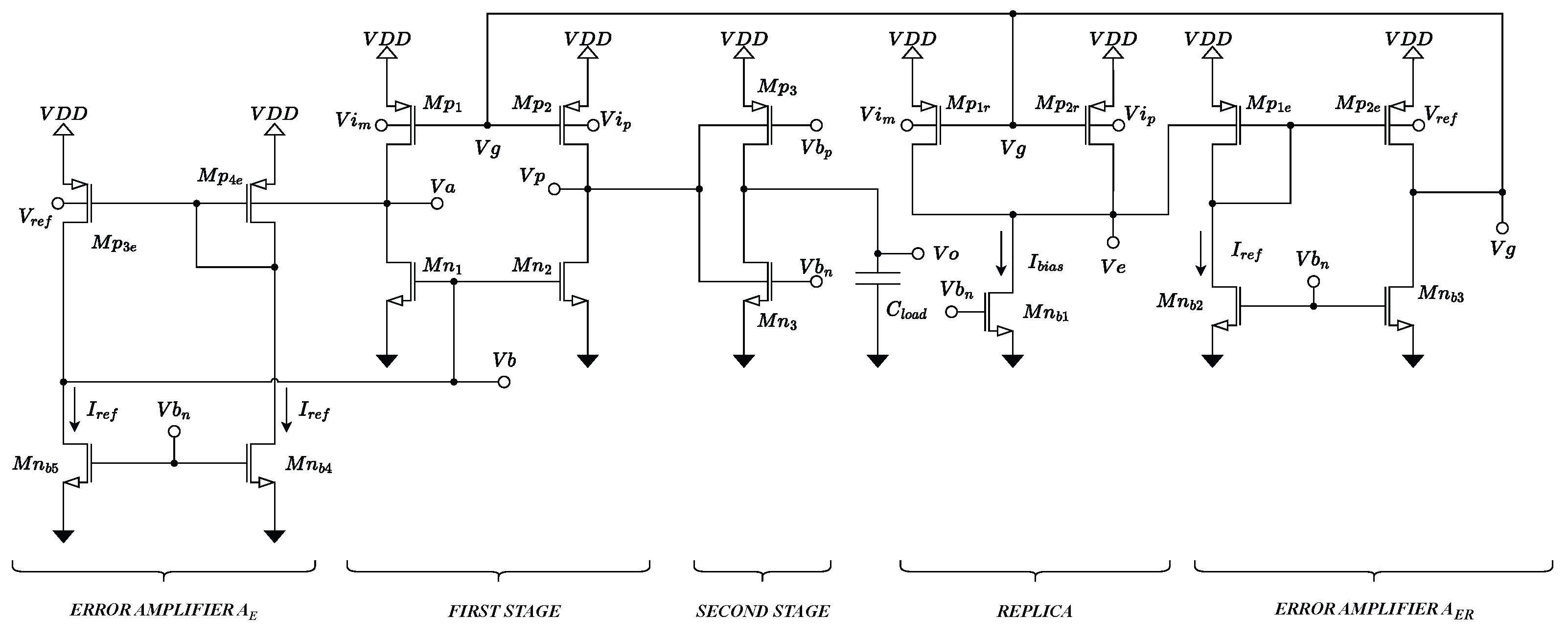


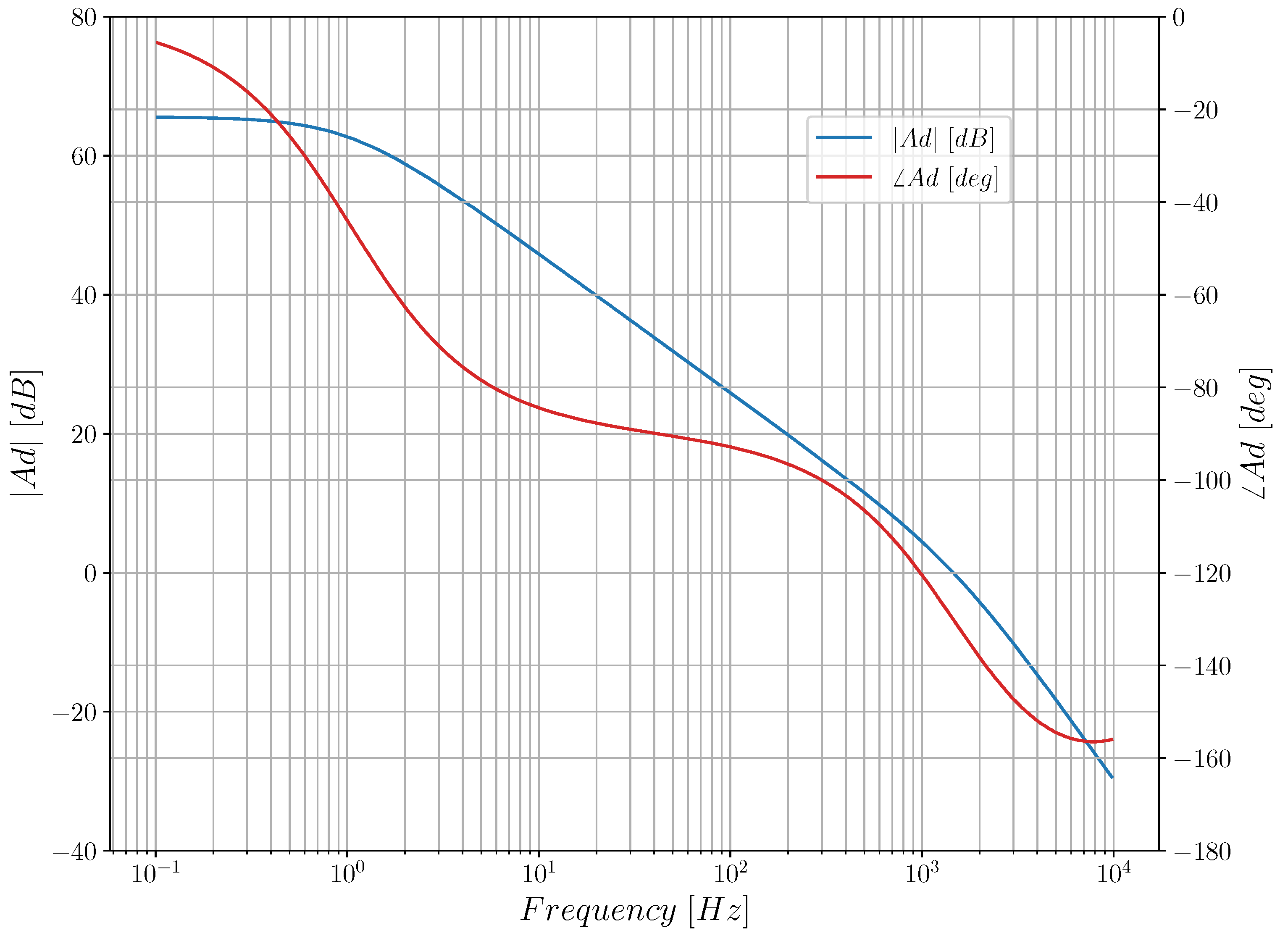
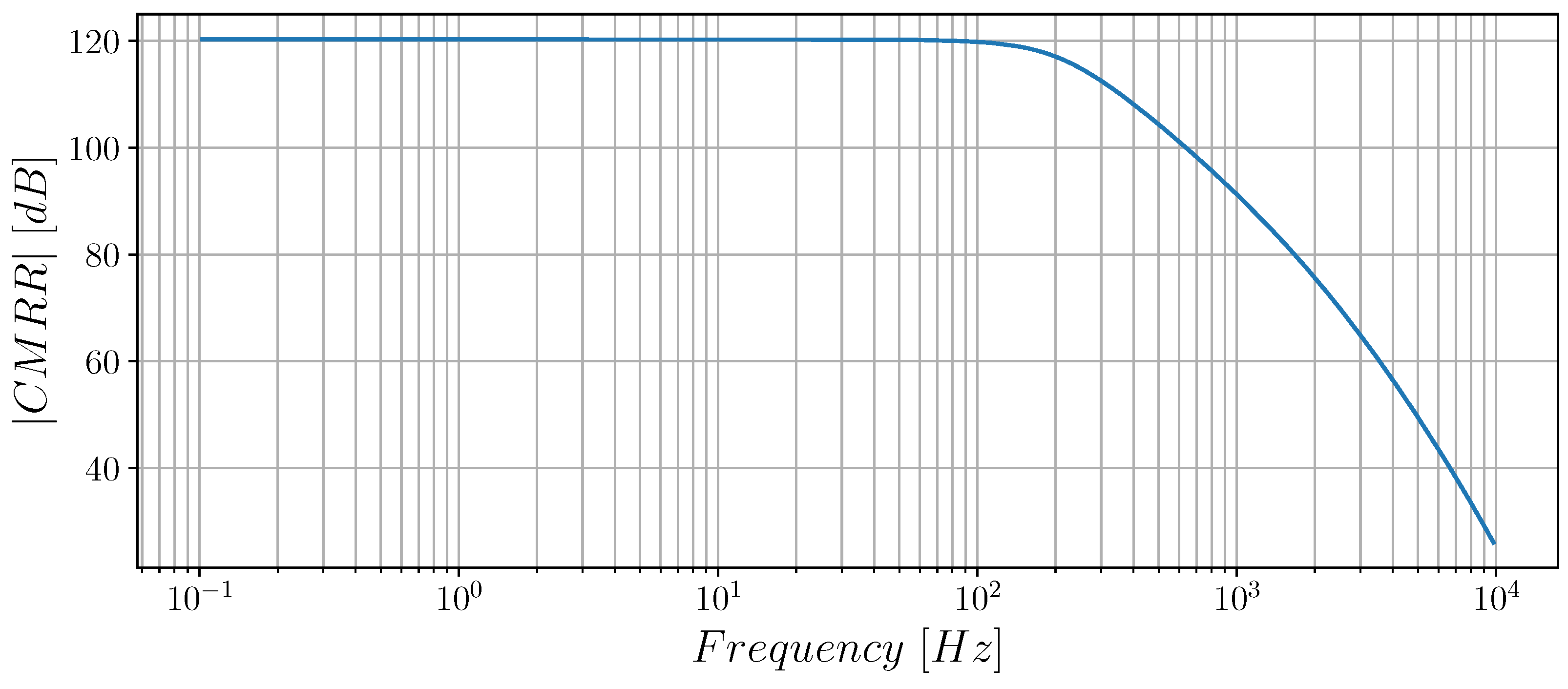
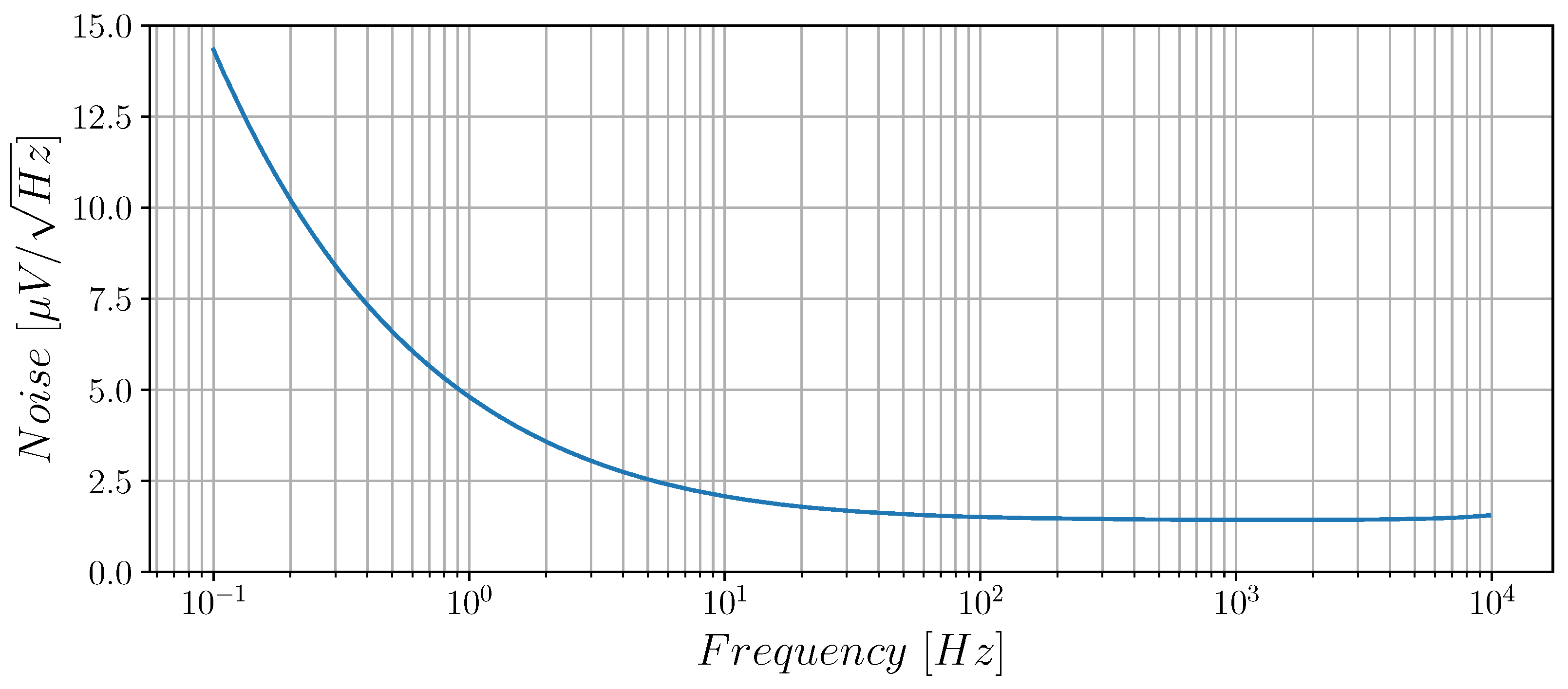
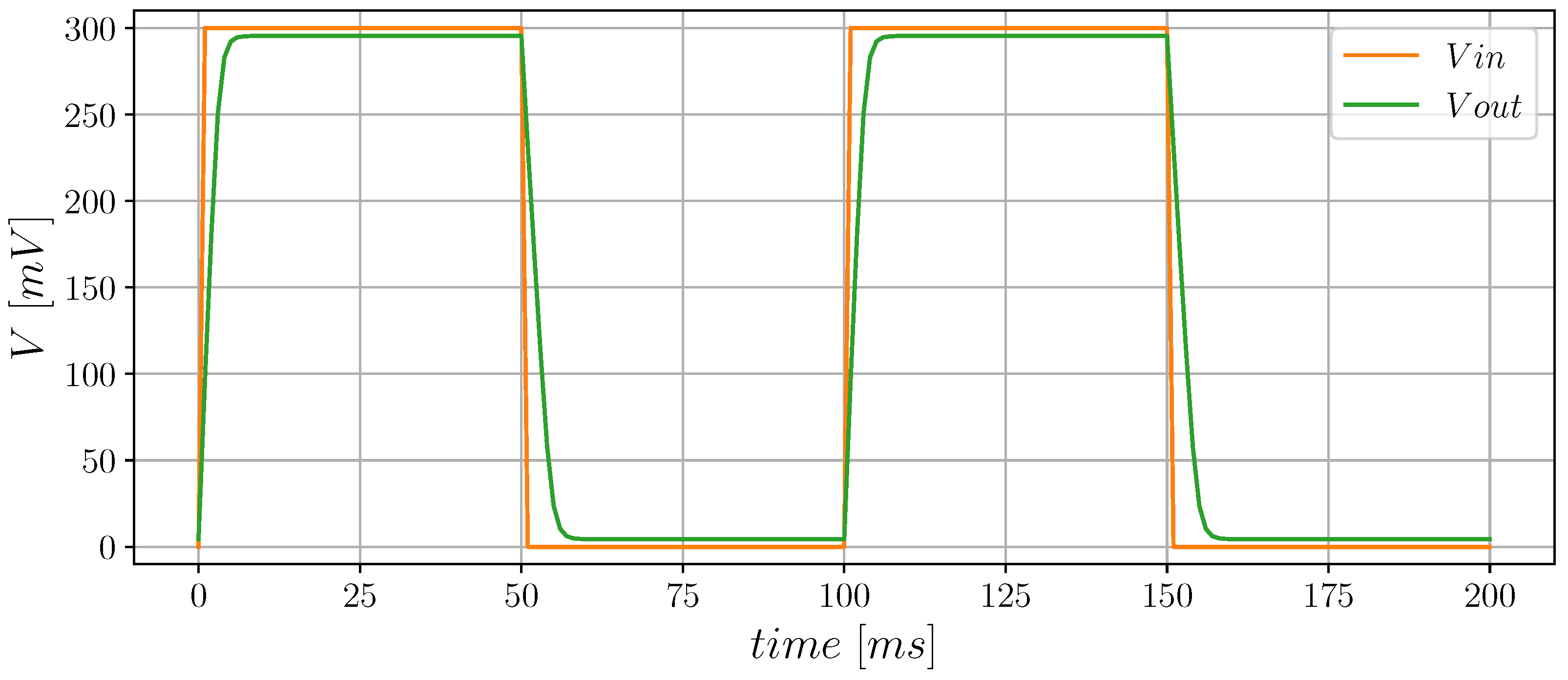
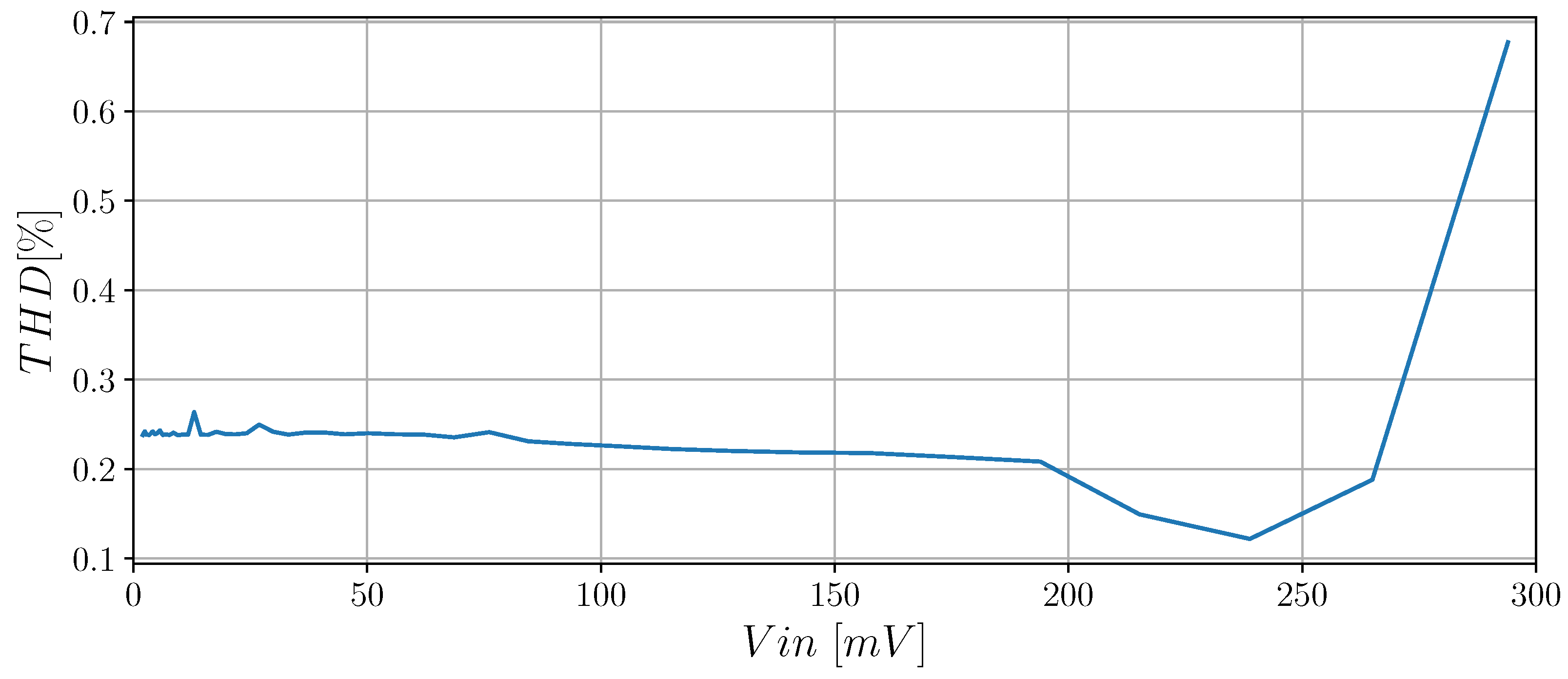
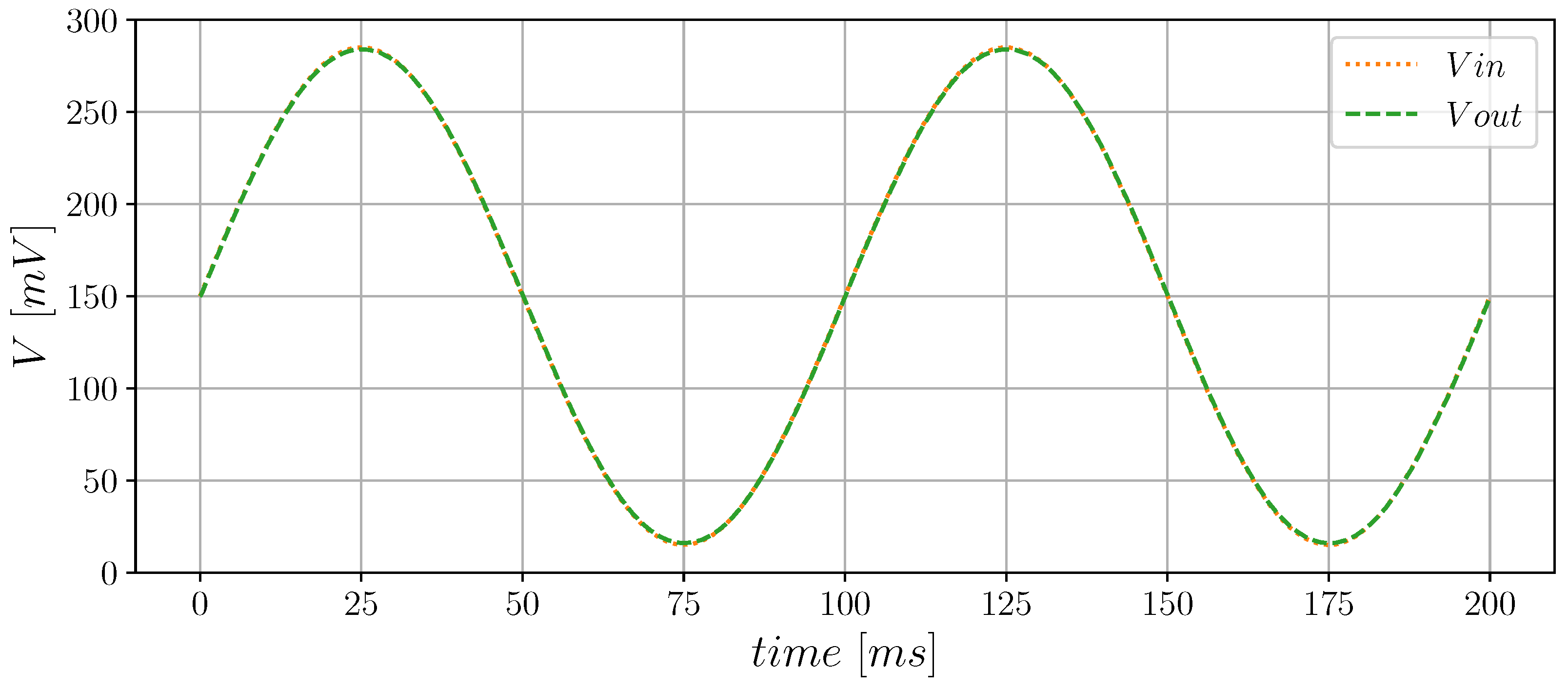

| W [µm] | L [µm] | [nA] | |
|---|---|---|---|
| Mp1,2 | 65 | 1 | 10 |
| Mn1,2 | 10 | 2.53 | 10 |
| Mp3 | 26 | 1 | 4 |
| Mn3 | 4 | 2.53 | 4 |
| 4 | 2.53 | 1 | |
| 6.5 | 1 | 1 | |
| 2 | 2.53 | 1 |
| Typ | FF | SS | SF | FS | Temp = 0 | Temp = 80 | Alim = 270 mV | Alim = 330 mV | |
|---|---|---|---|---|---|---|---|---|---|
| [dB] | 65.54 | 64.64 | 66.49 | 65.07 | 66.02 | 66.43 | 61.45 | 63.28 | 66.91 |
| [kHz] | 1.98 | 1.85 | 2.135 | 1.92 | 2.05 | 2.23 | 1.33 | 1.73 | 2.2 |
| [deg] | 49.87 | 52.66 | 51.29 | 47.07 | 48.47 | 48.23 | 60.77 | 46.51 | 54.56 |
| [dB] | −54.76 | −24.08 | −25.17 | −36.64 | −39.85 | −22.78 | −16.14 | −26.16 | −27.44 |
| [dB] | 120.3 | 88.72 | 91.66 | 101.71 | 105.87 | 89.21 | 77.59 | 89.44 | 94.35 |
| [dB] | 121.06 | 120.96 | 120.39 | 119.79 | 121.59 | 119.79 | 117.8 | 114.36 | 125.07 |
| [nW] | 9 | 9.05 | 8.96 | 8.98 | 9.02 | 8.95 | 9.19 | 8.07 | 9.93 |
| [fA] | 349.7 | 349.9 | 349.5 | 350.3 | 349.1 | 302.9 | 3406 | 225.9 | 544.2 |
| [mV] | 0 | 0.1 | 0.1 | 0 | 0 | 0.1 | 0.3 | 0.1 | 0 |
| [V/s] | 83.89 | 73.99 | 89.76 | 85.49 | 79.51 | 100.1 | 43.23 | 70.68 | 100.1 |
| [V/s] | 59 | 122.3 | 26.34 | 30.83 | 107.4 | 23.93 | 207.1 | 28.8 | 113.1 |
| [V/s] | 71.445 | 98.145 | 58.05 | 58.16 | 93.455 | 62.015 | 125.165 | 49.74 | 106.6 |
| [µV/] | 1.43 | 1.45 | 1.41 | 1.46 | 1.41 | 1.33 | 1.61 | 1.46 | 1.40 |
| (10 Hz, 270 mVpp) [%] | 0.24 | 0.239 | 0.238 | 0.242 | 0.237 | 0.238 | 0.248 | 0.241 | 0.247 |
| Corner | FF | SS | SF | FS | ||||||||||||
|---|---|---|---|---|---|---|---|---|---|---|---|---|---|---|---|---|
| VDD | 0.27 | 0.33 | 0.27 | 0.33 | 0.27 | 0.33 | 0.27 | 0.33 | ||||||||
| Temp | 0 | 80 | 0 | 80 | 0 | 80 | 0 | 80 | 0 | 80 | 0 | 80 | 0 | 80 | 0 | 80 |
| [dB] | 58.96 | 63.71 | 61.59 | 66.83 | 60.56 | 65.54 | 63.01 | 68.77 | 59.35 | 64.13 | 61.89 | 67.26 | 60.04 | 65.10 | 62.56 | 68.33 |
| [kHz] | 1.199 | 1.842 | 1.393 | 2.288 | 1.292 | 2.126 | 1.408 | 2.658 | 1.205 | 1.910 | 1.359 | 2.374 | 1.256 | 2.044 | 1.393 | 2.550 |
| [deg] | 65.850 | 55.190 | 63.240 | 47.970 | 60.930 | 49.870 | 58.690 | 42.460 | 64.330 | 53.910 | 61.630 | 46.660 | 62.770 | 51.050 | 60.540 | 43.730 |
| [dB] | −54.060 | −25.610 | −58.620 | −31.920 | −30.440 | −9.590 | −26.270 | −20.700 | −10.510 | −16.030 | −29.370 | −32.120 | −21.430 | −14.320 | −18.470 | −26.970 |
| [dB] | 113.020 | 89.320 | 120.210 | 98.750 | 91.000 | 75.130 | 89.280 | 89.470 | 69.860 | 80.160 | 91.260 | 99.380 | 81.470 | 79.420 | 81.030 | 95.300 |
| [dB] | 82.090 | 76.450 | 95.380 | 95.503 | 51.834 | 101.320 | 75.120 | 81.980 | 78.660 | 87.160 | 90.890 | 78.420 | 44.780 | 93.240 | 74.240 | 79.780 |
| [nW] | 8.563 | 8.065 | 10.990 | 9.919 | 8.131 | 7.940 | 10.050 | 9.839 | 8.177 | 8.015 | 10.190 | 9.858 | 8.416 | 8.009 | 10.620 | 9.899 |
| [mV] | −0.194 | 0.135 | −0.103 | 0.165 | −0.195 | 0.135 | −0.105 | 0.165 | −0.194 | 0.135 | −0.104 | 0.165 | −0.195 | 0.135 | 0.165 | 0.165 |
| [V/s] | 75.750 | 58.060 | 116.400 | 85.030 | 79.970 | 55.320 | 122.800 | 76.530 | 76.150 | 57.220 | 116.700 | 81.620 | 79.100 | 54.860 | 121.800 | 75.840 |
| [V/s] | 52.700 | 40.030 | 75.230 | 52.170 | 57.600 | 41.700 | 82.980 | 49.670 | 56.910 | 40.740 | 82.340 | 51.970 | 53.160 | 38.250 | 75.690 | 48.620 |
| [V/s] | 64 | 49 | 96 | 69 | 69 | 49 | 103 | 63 | 67 | 49 | 100 | 67 | 66 | 47 | 99 | 62 |
| [µV/] | 1.650 | 1.369 | 1.582 | 1.318 | 1.629 | 1.338 | 1.570 | 1.288 | 1.686 | 1.379 | 1.625 | 1.328 | 1.601 | 1.331 | 1.527 | 1.282 |
| (10 Hz, 1 mVpp) [%] | 0.241 | 0.241 | 0.238 | 0.239 | 0.240 | 0.239 | 0.238 | 0.241 | 0.240 | 0.239 | 0.240 | 0.239 | 0.242 | 0.239 | 0.238 | 0.239 |
| Typ | µ | ||
|---|---|---|---|
| [mV] | 0.013 | 0.187 | 1.95 |
| [dB] | 65.54 | 65.53 | 0.009 |
| [kHz] | 1.98 | 1.98 | 0.045 |
| [deg] | 49.87 | 49.88 | 0.86 |
| [dB] | 120.3 | 62.82 | 7.141 |
| [dB] | 121.06 | 75.58 | 8.75 |
| [V/s] | 83.89 | 83.63 | 3.57 |
| [V/s] | 59 | 58.87 | 1.99 |
| [V/s] | 71.445 | 71.25 | 2.78 |
| [nW] | 9 | 9.00 | 0.323 |
| [fA] | 349.7 | 349.5 | 7.245 |
| (10 Hz, 270 mVpp) [%] | 0.24 | 0.233 | 0.016 |
| This Work | [24] | [44] | [43] | [41] | [39] | [59] | [22] | [35] | [34] | [33] | [31] | [30] | |
|---|---|---|---|---|---|---|---|---|---|---|---|---|---|
| Year | 2023 | 2023 | 2023 | 2022 | 2022 | 2022 | 2021 | 2021 | 2020 | 2020 | 2020 | 2018 | 2017 |
| Tech [nm] | 180 | 28 | 130 | 130 | 65 | 130 | 180 | 180 | 65 | 180 | 180 | 180 | 130 |
| [V] | 0.3 | 0.3 | 0.3 | 0.3 | 0.25 | 0.3 | 0.35 | 0.3 | 0.25 | 0.3 | 0.3 | 0.3 | 0.25 |
| 0.6 | − | 0.86 | 0.86 | − | 0.86 | 0.7 | 0.6 | − | 0.6 | 0.6 | 0.6 | − | |
| [dB] | 65.54 | 66.39 | 86.83 | 41.28 | 90.88 | 52.92 | 83 | 30 | 70 | 98.1 | 68.9 | 65.8 | 63 |
| [pF] | 200 | 250 | 35 | 250 | 100 | 50 | 10 | 150 | 15 | 30 | 30 | 20 | 15 |
| [kHz] | 1.981 | 12.29 | 10.32 | 7.95 | 31.22 | 35.16 | 24.78 | 0.25 | 9.5 | 3.1 | 2.96 | 2.78 | 6.23 |
| [deg] | 49.87 | 68.42 | 58.27 | 52 | 78.18 | 52.4 | 61.48 | 90 | 89.9 | 54.2 | 52 | 61.2 | 62.5 |
| [dB] | 62.82 * | 105.7 ** | 57.8 * | 35.28 ** | 74.8 ** | 42.11 * | 98.59 ** | 41 *** | 62.5 ** | 60 *** | 110 *** | 72 *** | 69.8 ** |
| [dB] | 75.58 * | 74.59 ** | 46.59 * | 74.41 ** | 113.75 ** | 56.13 * | 94.74 ** | 30 *** | 38 ** | 61 *** | 56 *** | 62 *** | 66.5 ** |
| [V/ms] | 0.08389 | 3.51 | 2.5 | 1.25 | 8.61 | 18.61 | 2951 | − | 2 | 14 | 1.9 | 6.44 | − |
| [V/ms] | 0.05898 | 2.87 | 5 | 1.25 | 8.61 | 11.51 | 2869 | − | 2 | 4.2 | 6.4 | 7.8 | − |
| [V/ms] | 0.072 | 3.19 | 3.75 | 1.25 | 8.61 | 15.06 | 2910 | 0.085 | 2 | 9.1 | 4.15 | 7.12 | 2.15 |
| [%] | 0.24 | 1.72 | 0.2 | 3.15 | − | 0.673 | − | 2 | − | 0.49 | − | 1 | 0.3 |
| at swing [%] | 90 | 83 | 73 | 90 | − | 90 | − | 90 | − | 83 | − | 93 | 60 |
| [µV/] | 1.43 | 2 | 2.85 | 1.4 | 4.36 | 1.6 | 0.18 | 21 | − | 1.8 | 1.6 | 1.85 | 17.6 |
| at freq [Hz] | 1000 | 1000 | 10,000 | 10,000 | 1000 | 1000 | 1000 | − | − | − | − | − | 0.1 |
| [nW] | 9 | 44 | 33.73 | 120 | 32.77 | 21.89 | 35.04 | 2.4 | 26 | 13 | 12.6 | 15.4 | 20 |
| Mode | BD | DIG | BD | BD | BD | BD | GD | DIG | BD | BD | BD | BD | BD |
| Area [µm2] | 1410 | 625 | 2340 | 2350 | 3300 | 5200 | 13470 | 982 | 2000 | 9840 | 8500 | 8200 | − |
| 44.022 | 69.83 | 10.709 | 16.563 | 95.27 | 80.311 | 7.072 | 15.625 | 5.481 | 7.154 | 7.048 | 3.61 | 4.673 | |
| 1.6 | 18.125 | 3.891 | 2.604 | 26.274 | 34.399 | 830.479 | 5.313 | 1.154 | 21 | 9.881 | 9.247 | 1.613 |
Disclaimer/Publisher’s Note: The statements, opinions and data contained in all publications are solely those of the individual author(s) and contributor(s) and not of MDPI and/or the editor(s). MDPI and/or the editor(s) disclaim responsibility for any injury to people or property resulting from any ideas, methods, instructions or products referred to in the content. |
© 2024 by the authors. Licensee MDPI, Basel, Switzerland. This article is an open access article distributed under the terms and conditions of the Creative Commons Attribution (CC BY) license (https://creativecommons.org/licenses/by/4.0/).
Share and Cite
Della Sala, R.; Centurelli, F.; Scotti, G.; Trifiletti, A. A 0.3 V OTA with Enhanced CMRR and High Robustness to PVT Variations. J. Low Power Electron. Appl. 2024, 14, 21. https://doi.org/10.3390/jlpea14020021
Della Sala R, Centurelli F, Scotti G, Trifiletti A. A 0.3 V OTA with Enhanced CMRR and High Robustness to PVT Variations. Journal of Low Power Electronics and Applications. 2024; 14(2):21. https://doi.org/10.3390/jlpea14020021
Chicago/Turabian StyleDella Sala, Riccardo, Francesco Centurelli, Giuseppe Scotti, and Alessandro Trifiletti. 2024. "A 0.3 V OTA with Enhanced CMRR and High Robustness to PVT Variations" Journal of Low Power Electronics and Applications 14, no. 2: 21. https://doi.org/10.3390/jlpea14020021
APA StyleDella Sala, R., Centurelli, F., Scotti, G., & Trifiletti, A. (2024). A 0.3 V OTA with Enhanced CMRR and High Robustness to PVT Variations. Journal of Low Power Electronics and Applications, 14(2), 21. https://doi.org/10.3390/jlpea14020021









